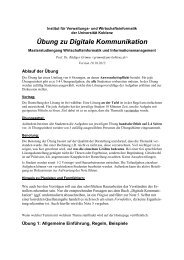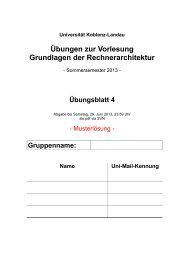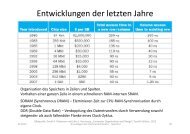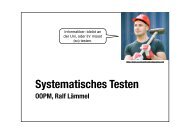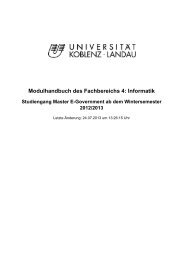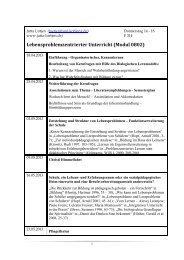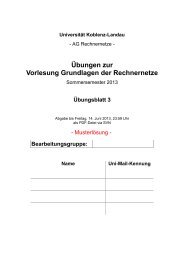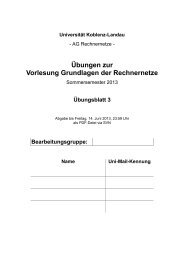Personalized grammar teaching on a tablet in inclusion classrooms
Personalized grammar teaching on a tablet in inclusion classrooms
Personalized grammar teaching on a tablet in inclusion classrooms
You also want an ePaper? Increase the reach of your titles
YUMPU automatically turns print PDFs into web optimized ePapers that Google loves.
<str<strong>on</strong>g>Pers<strong>on</strong>alized</str<strong>on</strong>g> <str<strong>on</strong>g>grammar</str<strong>on</strong>g> <str<strong>on</strong>g>teach<strong>in</strong>g</str<strong>on</strong>g> <strong>on</strong> a <strong>tablet</strong> <strong>in</strong> <strong>in</strong>clusi<strong>on</strong> <strong>classrooms</strong>Kar<strong>in</strong> Harbusch 1 , Christel-Joy Cameran 1 , Johannes Härtel 11 Department of Computer Science, University of Koblenz-Landau, Koblenz, Germany{harbusch|cameran|johanneshaertel}@uni-koblenz.de“Grammatical support tools allow people who have difficultieswith their <str<strong>on</strong>g>grammar</str<strong>on</strong>g> to make their comput<strong>in</strong>g and writ<strong>in</strong>g mucheasier. Good grammatical support can benefit even those withoutany learn<strong>in</strong>g disability or who do not th<strong>in</strong>k of themselves ashav<strong>in</strong>g any significant <str<strong>on</strong>g>grammar</str<strong>on</strong>g> troubles.“ 1 Suitable for thisgoal, we present the pers<strong>on</strong>alized <str<strong>on</strong>g>grammar</str<strong>on</strong>g> <str<strong>on</strong>g>teach<strong>in</strong>g</str<strong>on</strong>g> system IN-COMPASS for <strong>in</strong>clusi<strong>on</strong> <strong>classrooms</strong>. The system can be accommodatedto different age groups.IN-COMPASS is a new surface system operat<strong>in</strong>g <strong>on</strong> top of thelanguage-technology based core system COMPASS (cf. [1] forits most recent visualizati<strong>on</strong>). COMPASS is an acr<strong>on</strong>ym forCOMb<strong>in</strong>atorial and Paraphrastic Assembly of Sentence Structure.In the core system COMPASS, the student c<strong>on</strong>structs sentencesby compos<strong>in</strong>g syntactic trees out of lexically anchored“treelets” via a graphical drag&drop user <strong>in</strong>terface (“scaffoldedwrit<strong>in</strong>g” [2]). In COMPASS, an advanced user can explore alll<strong>in</strong>guistic details <strong>in</strong> an <strong>in</strong>teractive manner (self-paced and explorativelearn<strong>in</strong>g). A natural-language generator computes allpossible grammatically well-formed sentences entailed by thestudent-composed tree. It provides positive feedback if the student-composedtree bel<strong>on</strong>gs to the well-formed set, and negativefeedback otherwise. Proposals are based <strong>on</strong> a comparis<strong>on</strong> betweenthe student-composed tree and its own trees (<strong>in</strong>formativefeedback <strong>on</strong> demand). As feedback discusses the use of <str<strong>on</strong>g>grammar</str<strong>on</strong>g>rules, elementary syntactic knowledge is presupposed at thelearner’s side.In the follow<strong>in</strong>g, we first focus <strong>on</strong> the basic features for <str<strong>on</strong>g>grammar</str<strong>on</strong>g><str<strong>on</strong>g>teach<strong>in</strong>g</str<strong>on</strong>g> <strong>in</strong> the core system COMPASS. In turn, we outl<strong>in</strong>ewhich details rema<strong>in</strong> hidden by IN-COMPASS unless the pupil<strong>in</strong> an <strong>in</strong>clusive learn<strong>in</strong>g situati<strong>on</strong> asks for more <strong>in</strong>formati<strong>on</strong>.the learner first <strong>in</strong>flects a lemma accord<strong>in</strong>g to the grammaticalfuncti<strong>on</strong> without decid<strong>in</strong>g <strong>on</strong> its positi<strong>on</strong> <strong>in</strong> the c<strong>on</strong>stituentand/or <strong>in</strong> the sentence under c<strong>on</strong>structi<strong>on</strong>, resp. At any time dur<strong>in</strong>gscaffolded writ<strong>in</strong>g, partial word order<strong>in</strong>g can be performed.These results (even if wr<strong>on</strong>g) are kept dur<strong>in</strong>g further expansi<strong>on</strong>sof the dom<strong>in</strong>ance structure, e.g. by an Adjective.In an <strong>in</strong>itial phase, the l<strong>in</strong>guistic vocabulary used <strong>in</strong> visualizati<strong>on</strong>sand feedback messages can be adjusted to the term<strong>in</strong>ology<strong>in</strong> l<strong>in</strong>e with the user’s preferences. As the system provides alreadylists of different term<strong>in</strong>ologies <strong>in</strong> English and German, littlere-adjustment is necessary—same holds for the teachers <strong>in</strong> the<strong>in</strong>clusi<strong>on</strong> classroom prepar<strong>in</strong>g the use of IN-COMPASS.In Fig. 1, we exemplify a potential student acti<strong>on</strong> which is notapproved by the generator. The disagreement is graphically realizedby not unify<strong>in</strong>g the two treelets although the student hasmoved <strong>on</strong>e <strong>on</strong> top of the other (as the arrow <strong>in</strong>dicates). In theexample, we assume that the student had already successfullyc<strong>on</strong>structed a dom<strong>in</strong>ance tree for Anja baut ‘Anja builds’. In thistree, the student wants to add ihm ‘him’ (case DATIVE) at theDirect Object node. In Fig.1, it is still positi<strong>on</strong>ed close the desiredtarget leaf below the DOBJ node. However, it does not becomeattached because word form ihn (case ACCUSATIVE) isrequired <strong>in</strong>stead. Feedback is supplemented by traffic-light <strong>in</strong>spiredcolor-cod<strong>in</strong>g. Red highlights forbidden acti<strong>on</strong>s.COMPASS provides <strong>in</strong>tuitive graphical support for <str<strong>on</strong>g>grammar</str<strong>on</strong>g><str<strong>on</strong>g>teach<strong>in</strong>g</str<strong>on</strong>g>. For <strong>in</strong>stance, runn<strong>in</strong>g <strong>on</strong> a <strong>tablet</strong>, the student moves(parts of) trees around with the f<strong>in</strong>ger or a stylus, resp. Especially,word-order<strong>in</strong>g—which is a difficult topic for learners ofGerman—is performed by the student as graphical dialog withthe system, i.e. by mov<strong>in</strong>g branches <strong>in</strong>to field positi<strong>on</strong>s providedby the system (cf. the dark grey squared areas <strong>in</strong> the Figures).The syntactic <str<strong>on</strong>g>grammar</str<strong>on</strong>g> formalism underly<strong>in</strong>g COMPASS, isPerformance Grammar [3]. Due to psychol<strong>in</strong>guistic reas<strong>on</strong>s, itprovides a separati<strong>on</strong> <strong>in</strong>to dom<strong>in</strong>ance structures and l<strong>in</strong>ear order<strong>in</strong>g.“Scaffolded writ<strong>in</strong>g”—as performed <strong>in</strong> COMPASS—hasthe advantage that the students can c<strong>on</strong>centrate <strong>on</strong> very smallproblems <strong>in</strong> L2 sentence producti<strong>on</strong> <strong>in</strong> isolati<strong>on</strong>. For <strong>in</strong>stance,1 Quoted from a descripti<strong>on</strong> of the <strong>in</strong>clusive design research center atOCAD University, Canada (cf. http://idrc.ocad.ca/<strong>in</strong>dex.php/workshops-aamp-tra<strong>in</strong><strong>in</strong>gs/masters-program/13-resources/technical-glossary/37-grammatical-support-tools [last visit: 28th of June, 2013]).Figure 1. Illustrati<strong>on</strong> of a mismatch comb<strong>in</strong><strong>in</strong>g two treelets.In Fig. 2, the system’s warn<strong>in</strong>g reacti<strong>on</strong> to order<strong>in</strong>g Anja baute<strong>in</strong>e Rakete ihm ‘Anja builds a rocket him’ is del<strong>in</strong>eated. Thestudent has achieved this state by sort<strong>in</strong>g all filled grammaticalfuncti<strong>on</strong> nodes <strong>in</strong> the grey squared area attached to the HeadVerb. In Fig. 1, this box is empty because so far, the student hasc<strong>on</strong>centrated <strong>on</strong> the dom<strong>in</strong>ance structure. Although word order iswr<strong>on</strong>g, COMPASS does not reject any movement <strong>in</strong>to fields butit <strong>in</strong>dicates errors by <strong>in</strong>vert<strong>in</strong>g color to yellow so that the sen-
tence c<strong>on</strong>structi<strong>on</strong> can go <strong>on</strong> while word order<strong>in</strong>g is suspendedfor the time be<strong>in</strong>g. In this manner, the system “teaches” evencomplicated cases such as Scrambl<strong>in</strong>g <strong>in</strong> German subord<strong>in</strong>ateclauses to the student.Figure 2. Word order warn<strong>in</strong>g <strong>in</strong> Anja baut e<strong>in</strong>e Rakete ihm.IN-COMPASS provides elementary dialogue features similar tothe core versi<strong>on</strong> COMPASS, i.e. the students can drag&dropavoid<strong>in</strong>g typos <strong>on</strong> a <strong>tablet</strong> with the f<strong>in</strong>ger/stylo or <strong>on</strong> a PC us<strong>in</strong>gthe mouse/touch pad, resp. As additi<strong>on</strong>al feature of IN-COMPASS, a read-aloud functi<strong>on</strong> is always available. It is <strong>in</strong>dicatedby a loud-speaker butt<strong>on</strong> for every written text <strong>in</strong> order tosupport elementary school children <strong>in</strong> particular, but also dyslexicpupils <strong>in</strong> any classroom.Basically, a reduced lexical frame for an <strong>in</strong>flected word formexhibits its grammatical functi<strong>on</strong>s. The color-encoded fillers <strong>in</strong>the core system —<strong>on</strong>ly provid<strong>in</strong>g dist<strong>in</strong>guishable colors from thefeedback colors red/yellow/green — rema<strong>in</strong> unchanged as thisalready allows for easily guid<strong>in</strong>g the comb<strong>in</strong><strong>in</strong>g process withoutknow<strong>in</strong>g any l<strong>in</strong>guistic term. The nam<strong>in</strong>g of a grammatical functi<strong>on</strong>is <strong>in</strong>itially provided by the wh-questi<strong>on</strong> for the functi<strong>on</strong>(e.g., SUBJECT=WHO; cf. Fig. 3 for the lexical frame of baut‘builds’). Any Interrogative Pr<strong>on</strong>oun <strong>in</strong> the light grey grammatical-functi<strong>on</strong>layer—same as any visualized element <strong>in</strong> (IN-)COMPASS—can be selected to elicit a feedback dialogue. Inreturn, the system provides more details <strong>on</strong> the functi<strong>on</strong> (e.g.,different fill<strong>in</strong>g opti<strong>on</strong>s: for a subject, a Pers<strong>on</strong>al Pr<strong>on</strong>oun or acomplex Noun Phrase). Most importantly, the system w<strong>on</strong>derswhether the learner knows already the—so far hidden—technicalterm by provid<strong>in</strong>g a list of grammatical functi<strong>on</strong>s to choosefrom. In case of a wr<strong>on</strong>g answer, the system—as for any wr<strong>on</strong>ganswer—offers the correct answer <strong>on</strong> demand. Only if the userknew/wanted to know the term, the system suggests to replacethe wh-Pr<strong>on</strong>oun by the l<strong>in</strong>guistic term to be used by the system—asit is now learnt by the pupil. Thus, a pers<strong>on</strong>al level ofdetail becomes unveiled to the learner. As a c<strong>on</strong>sequence, a mixof Interrogative Pr<strong>on</strong>ouns and l<strong>in</strong>guistic terms is displayed regard<strong>in</strong>gto the user’s familiarity with <str<strong>on</strong>g>grammar</str<strong>on</strong>g> yet.Now we focus <strong>on</strong> the predef<strong>in</strong>ed layers of granularity hid<strong>in</strong>gaway detailed l<strong>in</strong>guistic <strong>in</strong>formati<strong>on</strong> <strong>in</strong> IN-COMPASS—unlessthe user asks for. Thus, every pupil <strong>in</strong> the classroom can work <strong>in</strong>an <strong>in</strong>dividualized manner with the system follow<strong>in</strong>g pers<strong>on</strong>algoals (self-paced and explorative learn<strong>in</strong>g).Especially, users who are disabled or at a young age should notbe c<strong>on</strong>fr<strong>on</strong>ted with elaborate syntactic trees full of very abstractl<strong>in</strong>guistic terms they do not understand. Nevertheless, there hasto be an elementary agreement <strong>on</strong> the use of words <strong>in</strong> a sentencebetween user and system <strong>in</strong> order to give adequate feedback toany acti<strong>on</strong> by the learner (cf. discussi<strong>on</strong>s <strong>in</strong> the CALL literature<strong>on</strong> pars<strong>in</strong>g-based systems which often have difficulties to providehelpful comments to errors by the learner; see, e.g., [4]).Therefore, IN-COMPASS works with reduced student-composedtrees—like COMPASS—<strong>in</strong>stead of sentences typed by the pupil.Thus, we completely avoid deal<strong>in</strong>g with typos, miss<strong>in</strong>g words,hardly any punctuati<strong>on</strong> although both systems, COMPASS andIN-COMPASS, resp., allow typ<strong>in</strong>g the desired word form. However,due to a nearest match procedure, <strong>on</strong>ly corrected lexicalframes can be selected/worked with.Figure 3. Reduced lexical frame for baut ‘builds’. Speakers supportstudents with read<strong>in</strong>g problems.Moreover, the system allows tra<strong>in</strong><strong>in</strong>g of word order variati<strong>on</strong>,where the Subject has to be moved away from its often chosensentence-<strong>in</strong>itial positi<strong>on</strong>. Of course, German speak<strong>in</strong>g pupils arecapable of understand<strong>in</strong>g any variati<strong>on</strong>. However, teachers compla<strong>in</strong>about when grad<strong>in</strong>g pupils’ essays that the pupils do notexhibit this variati<strong>on</strong> <strong>in</strong> writ<strong>in</strong>g very likely. Therefore, play<strong>in</strong>garound with sentences <strong>in</strong> order to understand the functi<strong>on</strong> of thesentence-<strong>in</strong>itial positi<strong>on</strong> <strong>in</strong> different c<strong>on</strong>texts can be elicited evenwith very reduced l<strong>in</strong>guistic knowledge.Due to lack of space, here we can neither elaborate <strong>on</strong> more l<strong>in</strong>guisticexplorati<strong>on</strong> modes (e.g., “<str<strong>on</strong>g>teach<strong>in</strong>g</str<strong>on</strong>g>”/let pupils f<strong>in</strong>d outwhat it means to be Head of a phrase <strong>in</strong> order to understand whya Prepositi<strong>on</strong> is the Head of a PP by play<strong>in</strong>g around with casevariati<strong>on</strong> such as <strong>in</strong> auf den/dem Bürgersteig ‘<strong>on</strong>to/<strong>on</strong> the sidewalk’)nor discuss the appropriate accommodati<strong>on</strong> to differentage groups <strong>in</strong> IN-COMPASS (e.g., the more but the shorter thefeedback by the system is the younger the pupils are <strong>in</strong> order toavoid overtax<strong>in</strong>g their attenti<strong>on</strong> span).Literature[1] Harbusch, K., Härtel, J. and Cameran, C.-J. “COMPASS III: Teach<strong>in</strong>g L2 <str<strong>on</strong>g>grammar</str<strong>on</strong>g> graphically <strong>on</strong> a <strong>tablet</strong> computer”, <strong>in</strong> Proceed<strong>in</strong>gs of SLaTE –Speech & language technology <strong>in</strong> educati<strong>on</strong>, Grenoble, August 2013.[2] Harbusch, K. and Kempen, G. “Automatic <strong>on</strong>l<strong>in</strong>e writ<strong>in</strong>g support for L2 learners of German through output m<strong>on</strong>itor<strong>in</strong>g by a natural-language paraphrasegenerator”, <strong>in</strong> M. Levy, F. Bl<strong>in</strong>, C. Bard<strong>in</strong> Sisk<strong>in</strong> and O. Takeuchi [Eds.], WORLDCALL, pp. 128-143, New York: Routledge, 2011.[3] Kempen, G. and Harbusch, K. “Performance Grammar: A declarative def<strong>in</strong>iti<strong>on</strong>”, <strong>in</strong> M. Theune, A. Nijholt and H. H<strong>on</strong>dorp [Eds], Computati<strong>on</strong>alL<strong>in</strong>guistics <strong>in</strong> the Netherlands 2001, pp. 146–162. Amsterdam: Rodopi, 2002.[4] Heift, T. and Schulze, M. (Eds.) (2003). “Error diagnosis and error correcti<strong>on</strong> <strong>in</strong> CALL”, CALICO Journal, 20(3).




